Business Environment Analysis: Primark, Nestle, and Global Impacts
VerifiedAdded on 2020/01/07
|20
|5719
|301
Report
AI Summary
This report provides a comprehensive analysis of the business environment, focusing on the operations of Primark and Nestle. It begins by identifying the purposes of different organizational types, including public, charity, and cooperative models, with Primark used as a case study to illustrate stakeholder objectives and strategic implementation. The report then delves into national business operations, examining resource allocation systems in various economies, including market and command economies, with a focus on the UK's market-based system. It discusses monetary and fiscal issues, as well as the regulatory framework. Further, the report explores the organizational market behavior of Primark and Nestle, analyzing the impact of market structures on pricing strategies, and the formation of organizational responses to market forces, alongside an environmental framework. Finally, it investigates the influence of global factors on business activities, including the importance of foreign trade, the effects of globalization, and the impact of European Union policies on UK business organizations, concluding with a summary of the key findings.

STUDENT NAME:
STUDENT ID:
SUBJECT CODE:
ASSIGNMENT NAME: BUSINESS ENVIRONMENT
STUDENT ID:
SUBJECT CODE:
ASSIGNMENT NAME: BUSINESS ENVIRONMENT
Paraphrase This Document
Need a fresh take? Get an instant paraphrase of this document with our AI Paraphraser
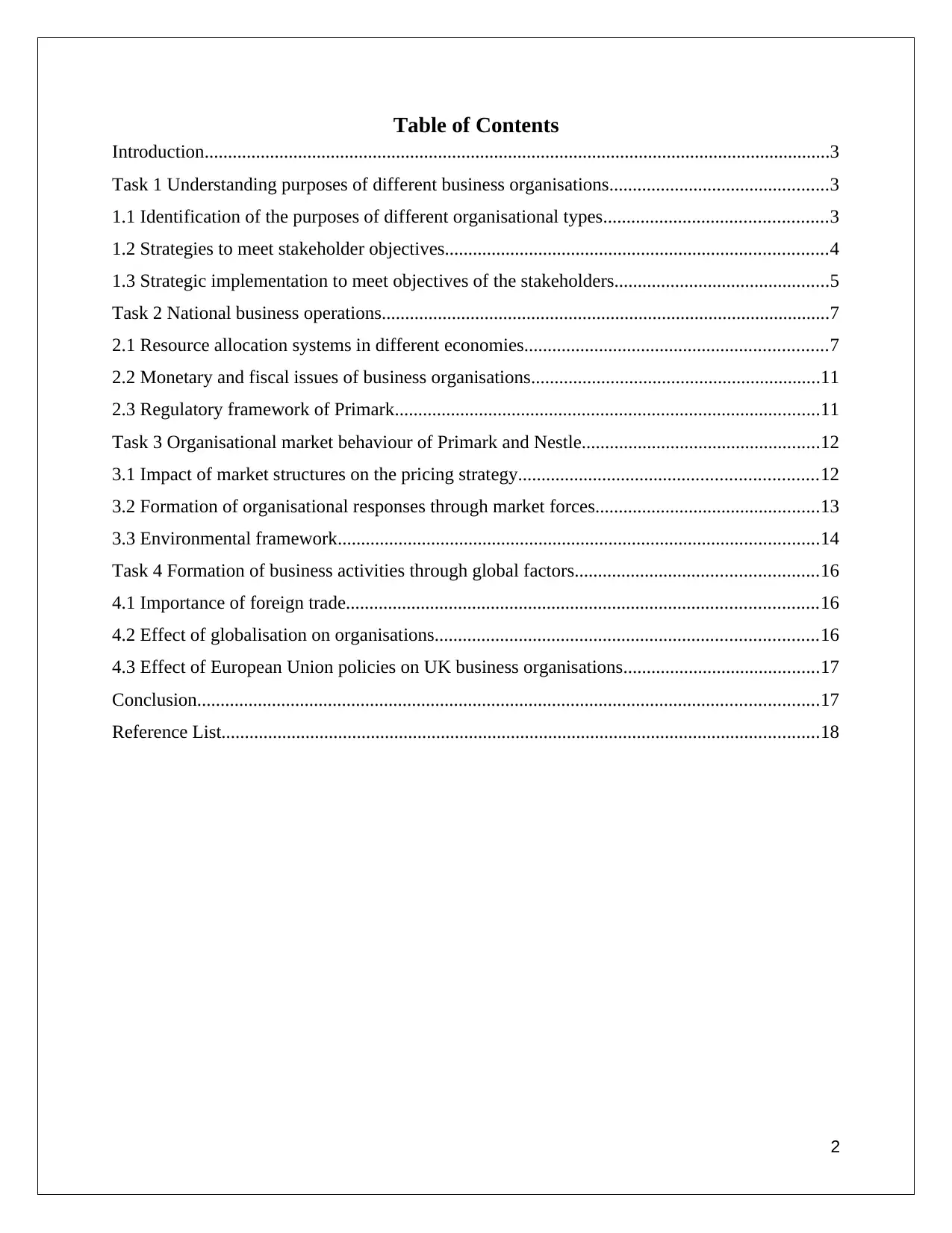
Table of Contents
Introduction......................................................................................................................................3
Task 1 Understanding purposes of different business organisations...............................................3
1.1 Identification of the purposes of different organisational types................................................3
1.2 Strategies to meet stakeholder objectives..................................................................................4
1.3 Strategic implementation to meet objectives of the stakeholders..............................................5
Task 2 National business operations................................................................................................7
2.1 Resource allocation systems in different economies.................................................................7
2.2 Monetary and fiscal issues of business organisations..............................................................11
2.3 Regulatory framework of Primark...........................................................................................11
Task 3 Organisational market behaviour of Primark and Nestle...................................................12
3.1 Impact of market structures on the pricing strategy................................................................12
3.2 Formation of organisational responses through market forces................................................13
3.3 Environmental framework.......................................................................................................14
Task 4 Formation of business activities through global factors....................................................16
4.1 Importance of foreign trade.....................................................................................................16
4.2 Effect of globalisation on organisations..................................................................................16
4.3 Effect of European Union policies on UK business organisations..........................................17
Conclusion.....................................................................................................................................17
Reference List................................................................................................................................18
2
Introduction......................................................................................................................................3
Task 1 Understanding purposes of different business organisations...............................................3
1.1 Identification of the purposes of different organisational types................................................3
1.2 Strategies to meet stakeholder objectives..................................................................................4
1.3 Strategic implementation to meet objectives of the stakeholders..............................................5
Task 2 National business operations................................................................................................7
2.1 Resource allocation systems in different economies.................................................................7
2.2 Monetary and fiscal issues of business organisations..............................................................11
2.3 Regulatory framework of Primark...........................................................................................11
Task 3 Organisational market behaviour of Primark and Nestle...................................................12
3.1 Impact of market structures on the pricing strategy................................................................12
3.2 Formation of organisational responses through market forces................................................13
3.3 Environmental framework.......................................................................................................14
Task 4 Formation of business activities through global factors....................................................16
4.1 Importance of foreign trade.....................................................................................................16
4.2 Effect of globalisation on organisations..................................................................................16
4.3 Effect of European Union policies on UK business organisations..........................................17
Conclusion.....................................................................................................................................17
Reference List................................................................................................................................18
2
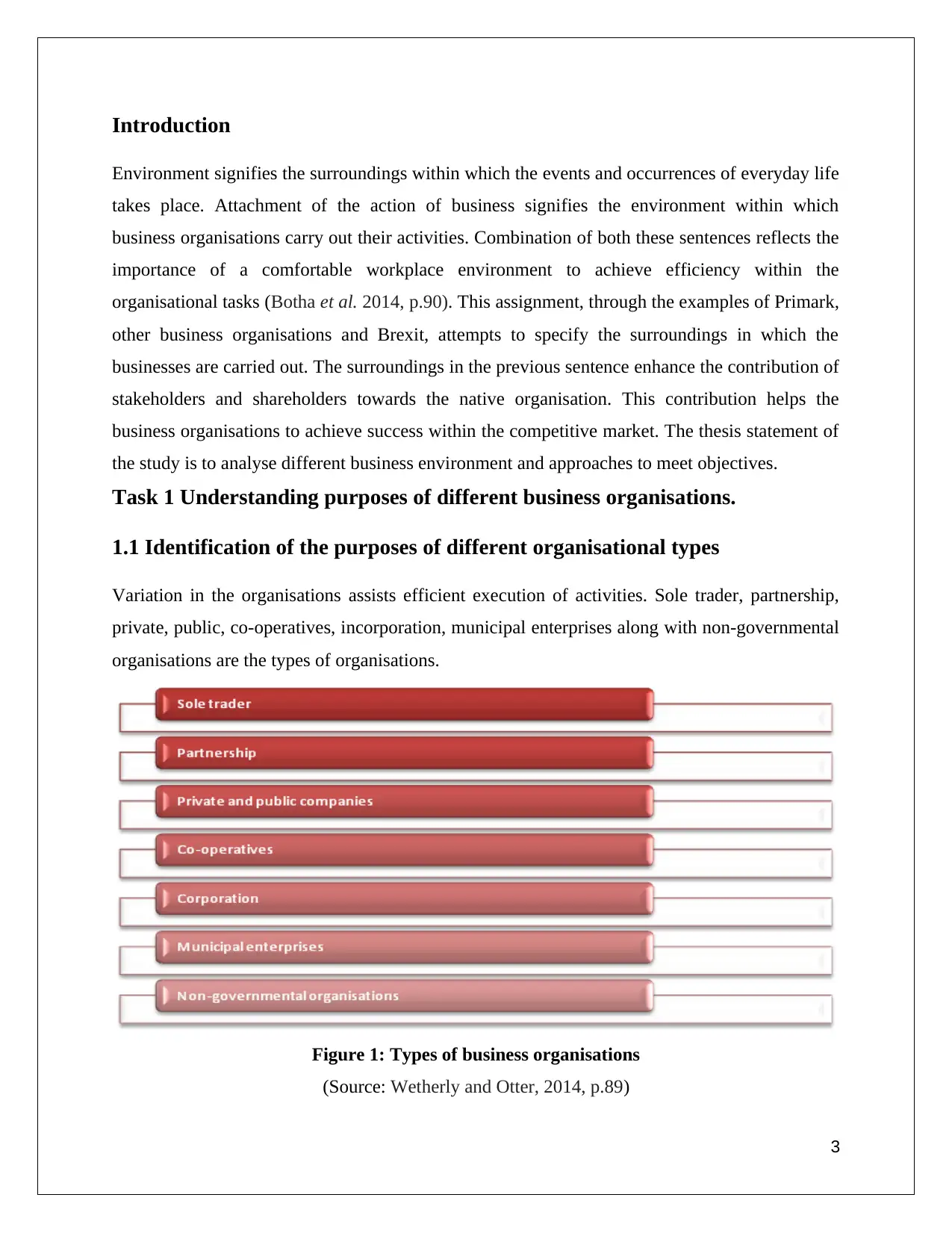
Introduction
Environment signifies the surroundings within which the events and occurrences of everyday life
takes place. Attachment of the action of business signifies the environment within which
business organisations carry out their activities. Combination of both these sentences reflects the
importance of a comfortable workplace environment to achieve efficiency within the
organisational tasks (Botha et al. 2014, p.90). This assignment, through the examples of Primark,
other business organisations and Brexit, attempts to specify the surroundings in which the
businesses are carried out. The surroundings in the previous sentence enhance the contribution of
stakeholders and shareholders towards the native organisation. This contribution helps the
business organisations to achieve success within the competitive market. The thesis statement of
the study is to analyse different business environment and approaches to meet objectives.
Task 1 Understanding purposes of different business organisations.
1.1 Identification of the purposes of different organisational types
Variation in the organisations assists efficient execution of activities. Sole trader, partnership,
private, public, co-operatives, incorporation, municipal enterprises along with non-governmental
organisations are the types of organisations.
Figure 1: Types of business organisations
(Source: Wetherly and Otter, 2014, p.89)
3
Environment signifies the surroundings within which the events and occurrences of everyday life
takes place. Attachment of the action of business signifies the environment within which
business organisations carry out their activities. Combination of both these sentences reflects the
importance of a comfortable workplace environment to achieve efficiency within the
organisational tasks (Botha et al. 2014, p.90). This assignment, through the examples of Primark,
other business organisations and Brexit, attempts to specify the surroundings in which the
businesses are carried out. The surroundings in the previous sentence enhance the contribution of
stakeholders and shareholders towards the native organisation. This contribution helps the
business organisations to achieve success within the competitive market. The thesis statement of
the study is to analyse different business environment and approaches to meet objectives.
Task 1 Understanding purposes of different business organisations.
1.1 Identification of the purposes of different organisational types
Variation in the organisations assists efficient execution of activities. Sole trader, partnership,
private, public, co-operatives, incorporation, municipal enterprises along with non-governmental
organisations are the types of organisations.
Figure 1: Types of business organisations
(Source: Wetherly and Otter, 2014, p.89)
3
⊘ This is a preview!⊘
Do you want full access?
Subscribe today to unlock all pages.

Trusted by 1+ million students worldwide
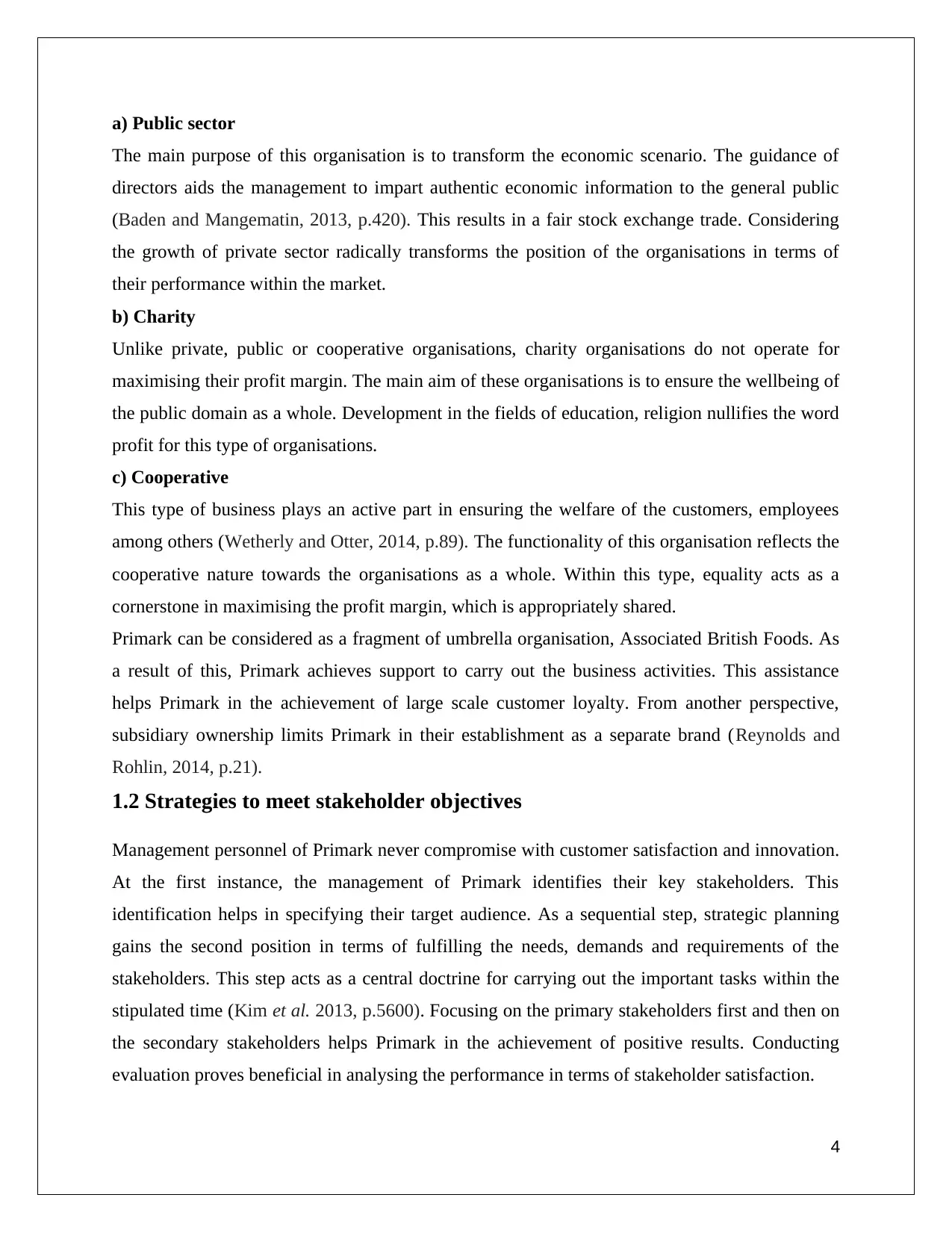
a) Public sector
The main purpose of this organisation is to transform the economic scenario. The guidance of
directors aids the management to impart authentic economic information to the general public
(Baden and Mangematin, 2013, p.420). This results in a fair stock exchange trade. Considering
the growth of private sector radically transforms the position of the organisations in terms of
their performance within the market.
b) Charity
Unlike private, public or cooperative organisations, charity organisations do not operate for
maximising their profit margin. The main aim of these organisations is to ensure the wellbeing of
the public domain as a whole. Development in the fields of education, religion nullifies the word
profit for this type of organisations.
c) Cooperative
This type of business plays an active part in ensuring the welfare of the customers, employees
among others (Wetherly and Otter, 2014, p.89). The functionality of this organisation reflects the
cooperative nature towards the organisations as a whole. Within this type, equality acts as a
cornerstone in maximising the profit margin, which is appropriately shared.
Primark can be considered as a fragment of umbrella organisation, Associated British Foods. As
a result of this, Primark achieves support to carry out the business activities. This assistance
helps Primark in the achievement of large scale customer loyalty. From another perspective,
subsidiary ownership limits Primark in their establishment as a separate brand (Reynolds and
Rohlin, 2014, p.21).
1.2 Strategies to meet stakeholder objectives
Management personnel of Primark never compromise with customer satisfaction and innovation.
At the first instance, the management of Primark identifies their key stakeholders. This
identification helps in specifying their target audience. As a sequential step, strategic planning
gains the second position in terms of fulfilling the needs, demands and requirements of the
stakeholders. This step acts as a central doctrine for carrying out the important tasks within the
stipulated time (Kim et al. 2013, p.5600). Focusing on the primary stakeholders first and then on
the secondary stakeholders helps Primark in the achievement of positive results. Conducting
evaluation proves beneficial in analysing the performance in terms of stakeholder satisfaction.
4
The main purpose of this organisation is to transform the economic scenario. The guidance of
directors aids the management to impart authentic economic information to the general public
(Baden and Mangematin, 2013, p.420). This results in a fair stock exchange trade. Considering
the growth of private sector radically transforms the position of the organisations in terms of
their performance within the market.
b) Charity
Unlike private, public or cooperative organisations, charity organisations do not operate for
maximising their profit margin. The main aim of these organisations is to ensure the wellbeing of
the public domain as a whole. Development in the fields of education, religion nullifies the word
profit for this type of organisations.
c) Cooperative
This type of business plays an active part in ensuring the welfare of the customers, employees
among others (Wetherly and Otter, 2014, p.89). The functionality of this organisation reflects the
cooperative nature towards the organisations as a whole. Within this type, equality acts as a
cornerstone in maximising the profit margin, which is appropriately shared.
Primark can be considered as a fragment of umbrella organisation, Associated British Foods. As
a result of this, Primark achieves support to carry out the business activities. This assistance
helps Primark in the achievement of large scale customer loyalty. From another perspective,
subsidiary ownership limits Primark in their establishment as a separate brand (Reynolds and
Rohlin, 2014, p.21).
1.2 Strategies to meet stakeholder objectives
Management personnel of Primark never compromise with customer satisfaction and innovation.
At the first instance, the management of Primark identifies their key stakeholders. This
identification helps in specifying their target audience. As a sequential step, strategic planning
gains the second position in terms of fulfilling the needs, demands and requirements of the
stakeholders. This step acts as a central doctrine for carrying out the important tasks within the
stipulated time (Kim et al. 2013, p.5600). Focusing on the primary stakeholders first and then on
the secondary stakeholders helps Primark in the achievement of positive results. Conducting
evaluation proves beneficial in analysing the performance in terms of stakeholder satisfaction.
4
Paraphrase This Document
Need a fresh take? Get an instant paraphrase of this document with our AI Paraphraser
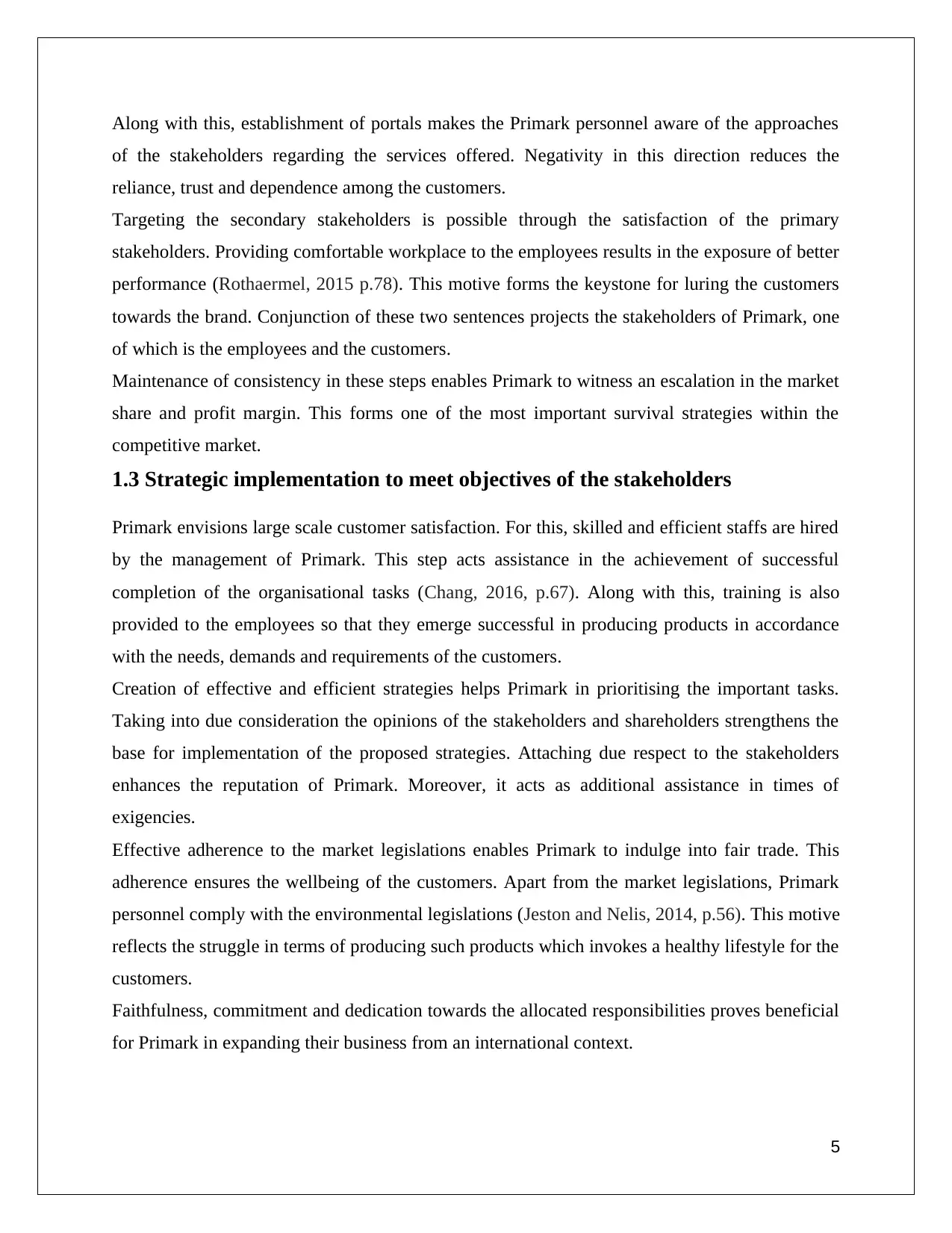
Along with this, establishment of portals makes the Primark personnel aware of the approaches
of the stakeholders regarding the services offered. Negativity in this direction reduces the
reliance, trust and dependence among the customers.
Targeting the secondary stakeholders is possible through the satisfaction of the primary
stakeholders. Providing comfortable workplace to the employees results in the exposure of better
performance (Rothaermel, 2015 p.78). This motive forms the keystone for luring the customers
towards the brand. Conjunction of these two sentences projects the stakeholders of Primark, one
of which is the employees and the customers.
Maintenance of consistency in these steps enables Primark to witness an escalation in the market
share and profit margin. This forms one of the most important survival strategies within the
competitive market.
1.3 Strategic implementation to meet objectives of the stakeholders
Primark envisions large scale customer satisfaction. For this, skilled and efficient staffs are hired
by the management of Primark. This step acts assistance in the achievement of successful
completion of the organisational tasks (Chang, 2016, p.67). Along with this, training is also
provided to the employees so that they emerge successful in producing products in accordance
with the needs, demands and requirements of the customers.
Creation of effective and efficient strategies helps Primark in prioritising the important tasks.
Taking into due consideration the opinions of the stakeholders and shareholders strengthens the
base for implementation of the proposed strategies. Attaching due respect to the stakeholders
enhances the reputation of Primark. Moreover, it acts as additional assistance in times of
exigencies.
Effective adherence to the market legislations enables Primark to indulge into fair trade. This
adherence ensures the wellbeing of the customers. Apart from the market legislations, Primark
personnel comply with the environmental legislations (Jeston and Nelis, 2014, p.56). This motive
reflects the struggle in terms of producing such products which invokes a healthy lifestyle for the
customers.
Faithfulness, commitment and dedication towards the allocated responsibilities proves beneficial
for Primark in expanding their business from an international context.
5
of the stakeholders regarding the services offered. Negativity in this direction reduces the
reliance, trust and dependence among the customers.
Targeting the secondary stakeholders is possible through the satisfaction of the primary
stakeholders. Providing comfortable workplace to the employees results in the exposure of better
performance (Rothaermel, 2015 p.78). This motive forms the keystone for luring the customers
towards the brand. Conjunction of these two sentences projects the stakeholders of Primark, one
of which is the employees and the customers.
Maintenance of consistency in these steps enables Primark to witness an escalation in the market
share and profit margin. This forms one of the most important survival strategies within the
competitive market.
1.3 Strategic implementation to meet objectives of the stakeholders
Primark envisions large scale customer satisfaction. For this, skilled and efficient staffs are hired
by the management of Primark. This step acts assistance in the achievement of successful
completion of the organisational tasks (Chang, 2016, p.67). Along with this, training is also
provided to the employees so that they emerge successful in producing products in accordance
with the needs, demands and requirements of the customers.
Creation of effective and efficient strategies helps Primark in prioritising the important tasks.
Taking into due consideration the opinions of the stakeholders and shareholders strengthens the
base for implementation of the proposed strategies. Attaching due respect to the stakeholders
enhances the reputation of Primark. Moreover, it acts as additional assistance in times of
exigencies.
Effective adherence to the market legislations enables Primark to indulge into fair trade. This
adherence ensures the wellbeing of the customers. Apart from the market legislations, Primark
personnel comply with the environmental legislations (Jeston and Nelis, 2014, p.56). This motive
reflects the struggle in terms of producing such products which invokes a healthy lifestyle for the
customers.
Faithfulness, commitment and dedication towards the allocated responsibilities proves beneficial
for Primark in expanding their business from an international context.
5

6
⊘ This is a preview!⊘
Do you want full access?
Subscribe today to unlock all pages.

Trusted by 1+ million students worldwide
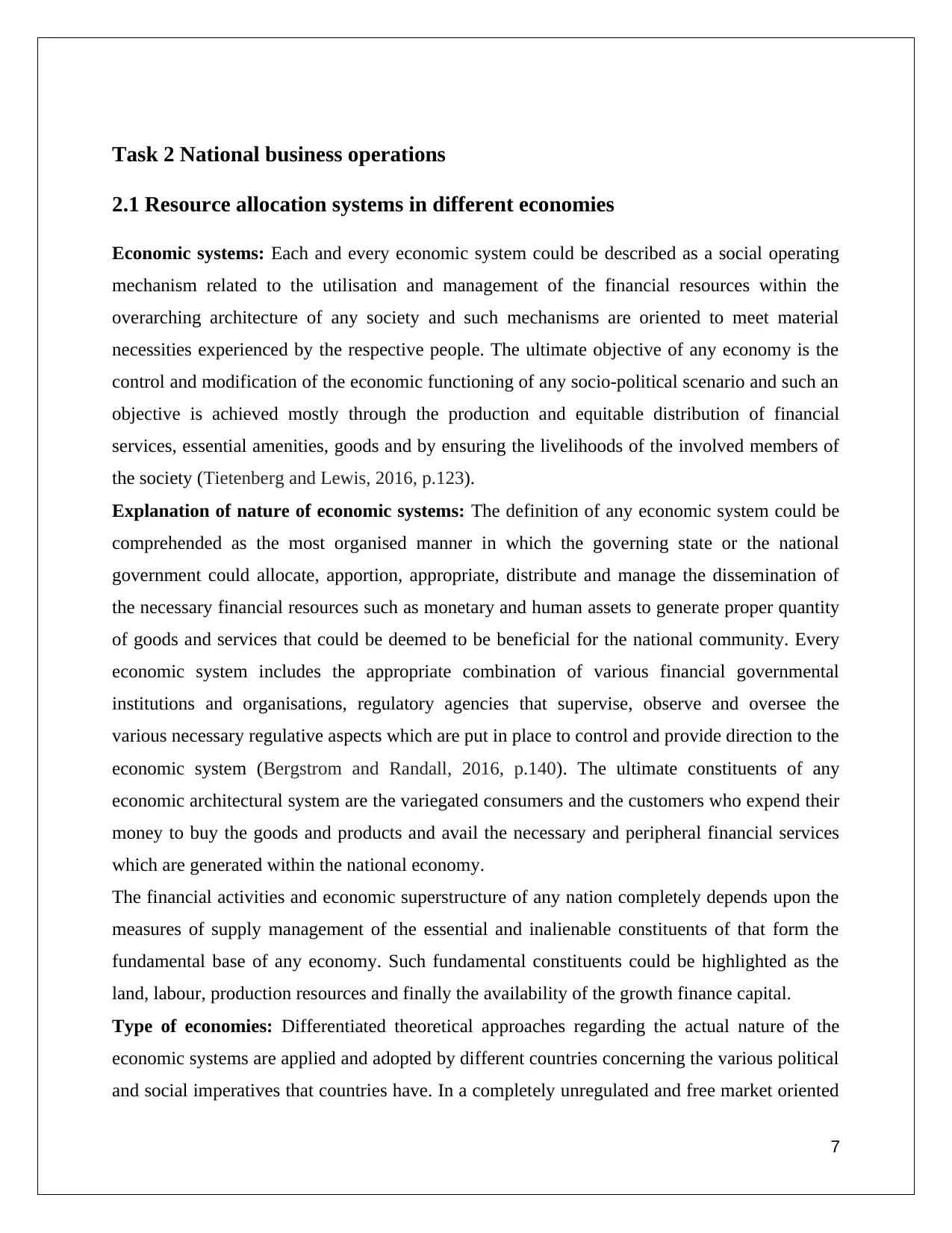
Task 2 National business operations
2.1 Resource allocation systems in different economies
Economic systems: Each and every economic system could be described as a social operating
mechanism related to the utilisation and management of the financial resources within the
overarching architecture of any society and such mechanisms are oriented to meet material
necessities experienced by the respective people. The ultimate objective of any economy is the
control and modification of the economic functioning of any socio-political scenario and such an
objective is achieved mostly through the production and equitable distribution of financial
services, essential amenities, goods and by ensuring the livelihoods of the involved members of
the society (Tietenberg and Lewis, 2016, p.123).
Explanation of nature of economic systems: The definition of any economic system could be
comprehended as the most organised manner in which the governing state or the national
government could allocate, apportion, appropriate, distribute and manage the dissemination of
the necessary financial resources such as monetary and human assets to generate proper quantity
of goods and services that could be deemed to be beneficial for the national community. Every
economic system includes the appropriate combination of various financial governmental
institutions and organisations, regulatory agencies that supervise, observe and oversee the
various necessary regulative aspects which are put in place to control and provide direction to the
economic system (Bergstrom and Randall, 2016, p.140). The ultimate constituents of any
economic architectural system are the variegated consumers and the customers who expend their
money to buy the goods and products and avail the necessary and peripheral financial services
which are generated within the national economy.
The financial activities and economic superstructure of any nation completely depends upon the
measures of supply management of the essential and inalienable constituents of that form the
fundamental base of any economy. Such fundamental constituents could be highlighted as the
land, labour, production resources and finally the availability of the growth finance capital.
Type of economies: Differentiated theoretical approaches regarding the actual nature of the
economic systems are applied and adopted by different countries concerning the various political
and social imperatives that countries have. In a completely unregulated and free market oriented
7
2.1 Resource allocation systems in different economies
Economic systems: Each and every economic system could be described as a social operating
mechanism related to the utilisation and management of the financial resources within the
overarching architecture of any society and such mechanisms are oriented to meet material
necessities experienced by the respective people. The ultimate objective of any economy is the
control and modification of the economic functioning of any socio-political scenario and such an
objective is achieved mostly through the production and equitable distribution of financial
services, essential amenities, goods and by ensuring the livelihoods of the involved members of
the society (Tietenberg and Lewis, 2016, p.123).
Explanation of nature of economic systems: The definition of any economic system could be
comprehended as the most organised manner in which the governing state or the national
government could allocate, apportion, appropriate, distribute and manage the dissemination of
the necessary financial resources such as monetary and human assets to generate proper quantity
of goods and services that could be deemed to be beneficial for the national community. Every
economic system includes the appropriate combination of various financial governmental
institutions and organisations, regulatory agencies that supervise, observe and oversee the
various necessary regulative aspects which are put in place to control and provide direction to the
economic system (Bergstrom and Randall, 2016, p.140). The ultimate constituents of any
economic architectural system are the variegated consumers and the customers who expend their
money to buy the goods and products and avail the necessary and peripheral financial services
which are generated within the national economy.
The financial activities and economic superstructure of any nation completely depends upon the
measures of supply management of the essential and inalienable constituents of that form the
fundamental base of any economy. Such fundamental constituents could be highlighted as the
land, labour, production resources and finally the availability of the growth finance capital.
Type of economies: Differentiated theoretical approaches regarding the actual nature of the
economic systems are applied and adopted by different countries concerning the various political
and social imperatives that countries have. In a completely unregulated and free market oriented
7
Paraphrase This Document
Need a fresh take? Get an instant paraphrase of this document with our AI Paraphraser
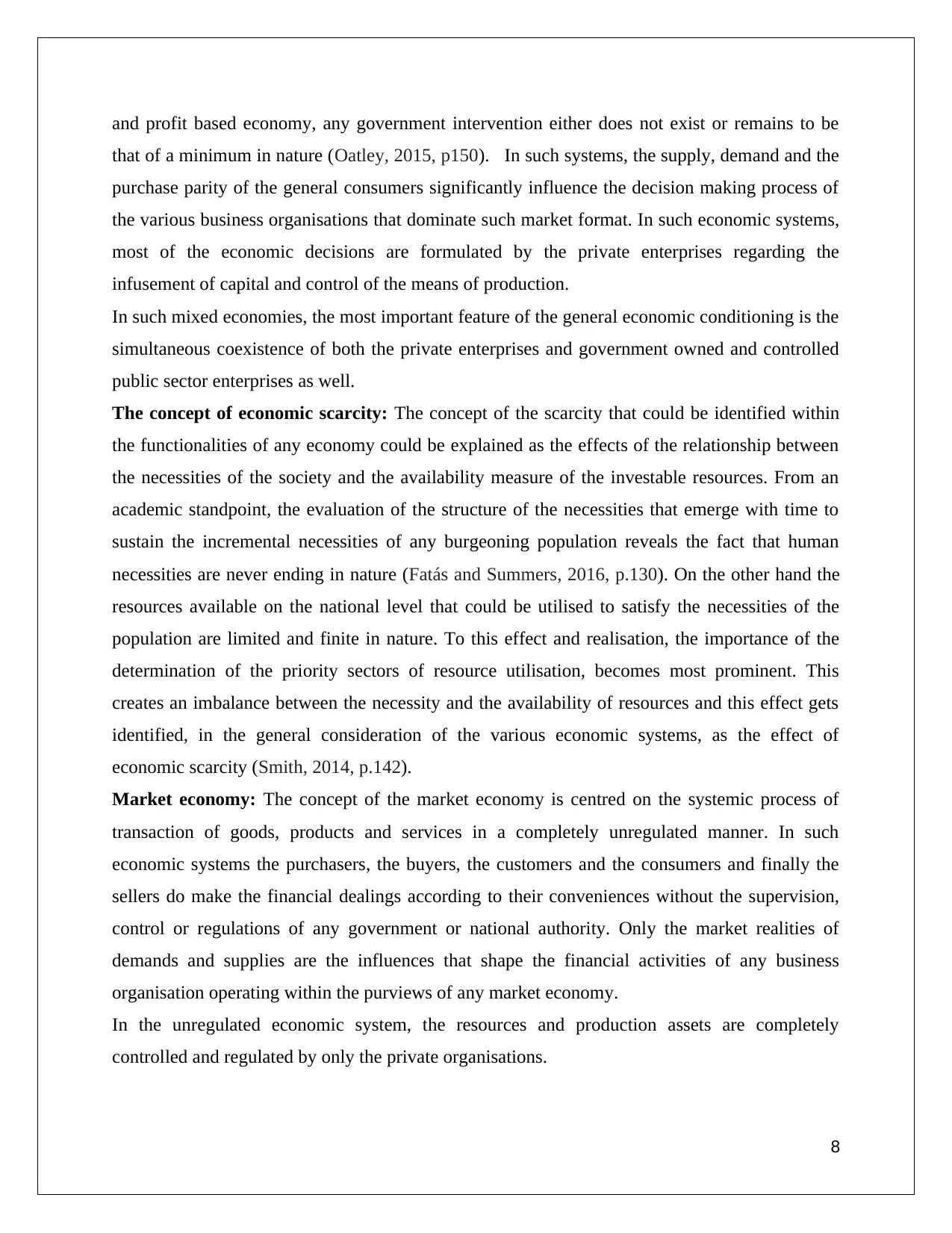
and profit based economy, any government intervention either does not exist or remains to be
that of a minimum in nature (Oatley, 2015, p150). In such systems, the supply, demand and the
purchase parity of the general consumers significantly influence the decision making process of
the various business organisations that dominate such market format. In such economic systems,
most of the economic decisions are formulated by the private enterprises regarding the
infusement of capital and control of the means of production.
In such mixed economies, the most important feature of the general economic conditioning is the
simultaneous coexistence of both the private enterprises and government owned and controlled
public sector enterprises as well.
The concept of economic scarcity: The concept of the scarcity that could be identified within
the functionalities of any economy could be explained as the effects of the relationship between
the necessities of the society and the availability measure of the investable resources. From an
academic standpoint, the evaluation of the structure of the necessities that emerge with time to
sustain the incremental necessities of any burgeoning population reveals the fact that human
necessities are never ending in nature (Fatás and Summers, 2016, p.130). On the other hand the
resources available on the national level that could be utilised to satisfy the necessities of the
population are limited and finite in nature. To this effect and realisation, the importance of the
determination of the priority sectors of resource utilisation, becomes most prominent. This
creates an imbalance between the necessity and the availability of resources and this effect gets
identified, in the general consideration of the various economic systems, as the effect of
economic scarcity (Smith, 2014, p.142).
Market economy: The concept of the market economy is centred on the systemic process of
transaction of goods, products and services in a completely unregulated manner. In such
economic systems the purchasers, the buyers, the customers and the consumers and finally the
sellers do make the financial dealings according to their conveniences without the supervision,
control or regulations of any government or national authority. Only the market realities of
demands and supplies are the influences that shape the financial activities of any business
organisation operating within the purviews of any market economy.
In the unregulated economic system, the resources and production assets are completely
controlled and regulated by only the private organisations.
8
that of a minimum in nature (Oatley, 2015, p150). In such systems, the supply, demand and the
purchase parity of the general consumers significantly influence the decision making process of
the various business organisations that dominate such market format. In such economic systems,
most of the economic decisions are formulated by the private enterprises regarding the
infusement of capital and control of the means of production.
In such mixed economies, the most important feature of the general economic conditioning is the
simultaneous coexistence of both the private enterprises and government owned and controlled
public sector enterprises as well.
The concept of economic scarcity: The concept of the scarcity that could be identified within
the functionalities of any economy could be explained as the effects of the relationship between
the necessities of the society and the availability measure of the investable resources. From an
academic standpoint, the evaluation of the structure of the necessities that emerge with time to
sustain the incremental necessities of any burgeoning population reveals the fact that human
necessities are never ending in nature (Fatás and Summers, 2016, p.130). On the other hand the
resources available on the national level that could be utilised to satisfy the necessities of the
population are limited and finite in nature. To this effect and realisation, the importance of the
determination of the priority sectors of resource utilisation, becomes most prominent. This
creates an imbalance between the necessity and the availability of resources and this effect gets
identified, in the general consideration of the various economic systems, as the effect of
economic scarcity (Smith, 2014, p.142).
Market economy: The concept of the market economy is centred on the systemic process of
transaction of goods, products and services in a completely unregulated manner. In such
economic systems the purchasers, the buyers, the customers and the consumers and finally the
sellers do make the financial dealings according to their conveniences without the supervision,
control or regulations of any government or national authority. Only the market realities of
demands and supplies are the influences that shape the financial activities of any business
organisation operating within the purviews of any market economy.
In the unregulated economic system, the resources and production assets are completely
controlled and regulated by only the private organisations.
8
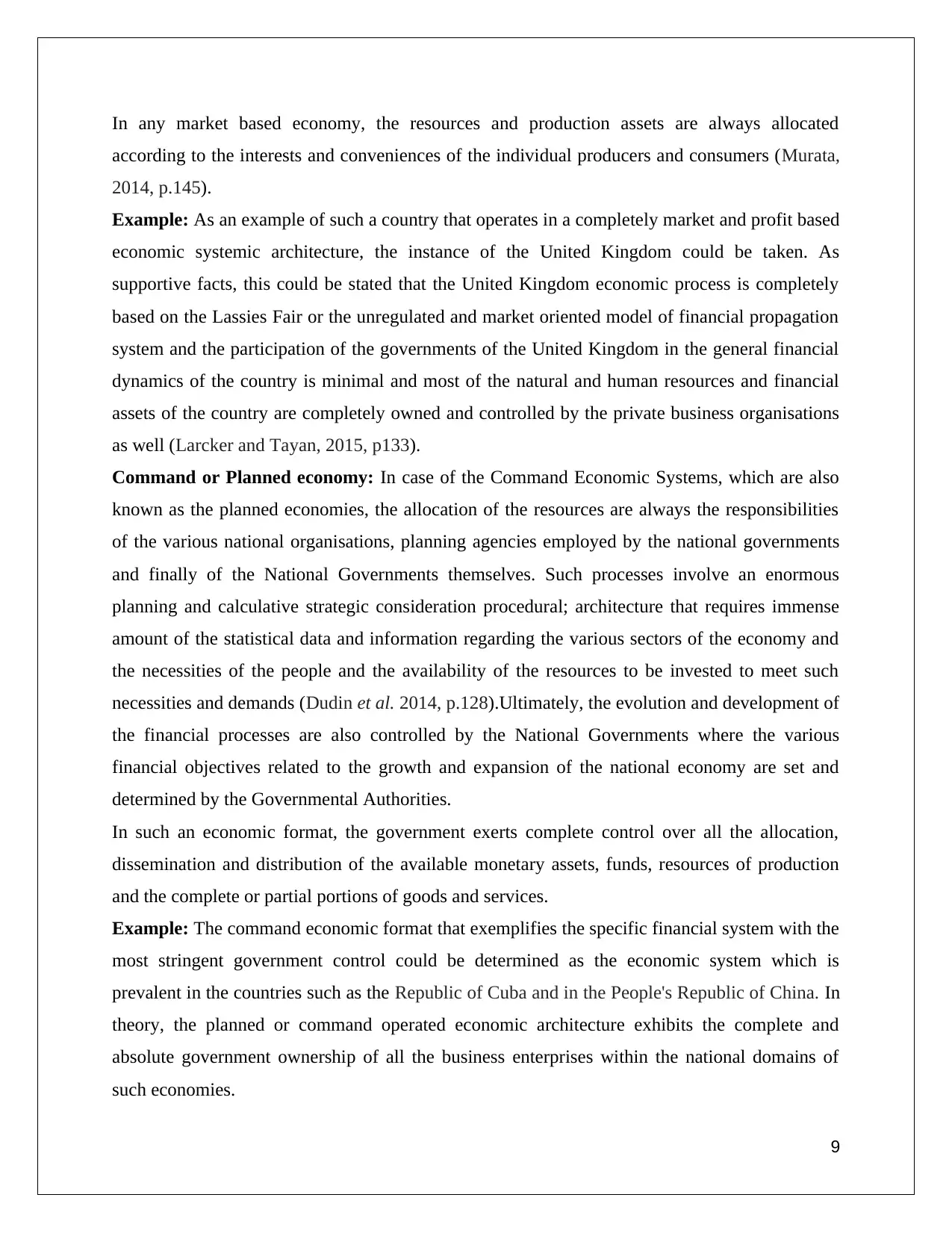
In any market based economy, the resources and production assets are always allocated
according to the interests and conveniences of the individual producers and consumers (Murata,
2014, p.145).
Example: As an example of such a country that operates in a completely market and profit based
economic systemic architecture, the instance of the United Kingdom could be taken. As
supportive facts, this could be stated that the United Kingdom economic process is completely
based on the Lassies Fair or the unregulated and market oriented model of financial propagation
system and the participation of the governments of the United Kingdom in the general financial
dynamics of the country is minimal and most of the natural and human resources and financial
assets of the country are completely owned and controlled by the private business organisations
as well (Larcker and Tayan, 2015, p133).
Command or Planned economy: In case of the Command Economic Systems, which are also
known as the planned economies, the allocation of the resources are always the responsibilities
of the various national organisations, planning agencies employed by the national governments
and finally of the National Governments themselves. Such processes involve an enormous
planning and calculative strategic consideration procedural; architecture that requires immense
amount of the statistical data and information regarding the various sectors of the economy and
the necessities of the people and the availability of the resources to be invested to meet such
necessities and demands (Dudin et al. 2014, p.128).Ultimately, the evolution and development of
the financial processes are also controlled by the National Governments where the various
financial objectives related to the growth and expansion of the national economy are set and
determined by the Governmental Authorities.
In such an economic format, the government exerts complete control over all the allocation,
dissemination and distribution of the available monetary assets, funds, resources of production
and the complete or partial portions of goods and services.
Example: The command economic format that exemplifies the specific financial system with the
most stringent government control could be determined as the economic system which is
prevalent in the countries such as the Republic of Cuba and in the People's Republic of China. In
theory, the planned or command operated economic architecture exhibits the complete and
absolute government ownership of all the business enterprises within the national domains of
such economies.
9
according to the interests and conveniences of the individual producers and consumers (Murata,
2014, p.145).
Example: As an example of such a country that operates in a completely market and profit based
economic systemic architecture, the instance of the United Kingdom could be taken. As
supportive facts, this could be stated that the United Kingdom economic process is completely
based on the Lassies Fair or the unregulated and market oriented model of financial propagation
system and the participation of the governments of the United Kingdom in the general financial
dynamics of the country is minimal and most of the natural and human resources and financial
assets of the country are completely owned and controlled by the private business organisations
as well (Larcker and Tayan, 2015, p133).
Command or Planned economy: In case of the Command Economic Systems, which are also
known as the planned economies, the allocation of the resources are always the responsibilities
of the various national organisations, planning agencies employed by the national governments
and finally of the National Governments themselves. Such processes involve an enormous
planning and calculative strategic consideration procedural; architecture that requires immense
amount of the statistical data and information regarding the various sectors of the economy and
the necessities of the people and the availability of the resources to be invested to meet such
necessities and demands (Dudin et al. 2014, p.128).Ultimately, the evolution and development of
the financial processes are also controlled by the National Governments where the various
financial objectives related to the growth and expansion of the national economy are set and
determined by the Governmental Authorities.
In such an economic format, the government exerts complete control over all the allocation,
dissemination and distribution of the available monetary assets, funds, resources of production
and the complete or partial portions of goods and services.
Example: The command economic format that exemplifies the specific financial system with the
most stringent government control could be determined as the economic system which is
prevalent in the countries such as the Republic of Cuba and in the People's Republic of China. In
theory, the planned or command operated economic architecture exhibits the complete and
absolute government ownership of all the business enterprises within the national domains of
such economies.
9
⊘ This is a preview!⊘
Do you want full access?
Subscribe today to unlock all pages.

Trusted by 1+ million students worldwide
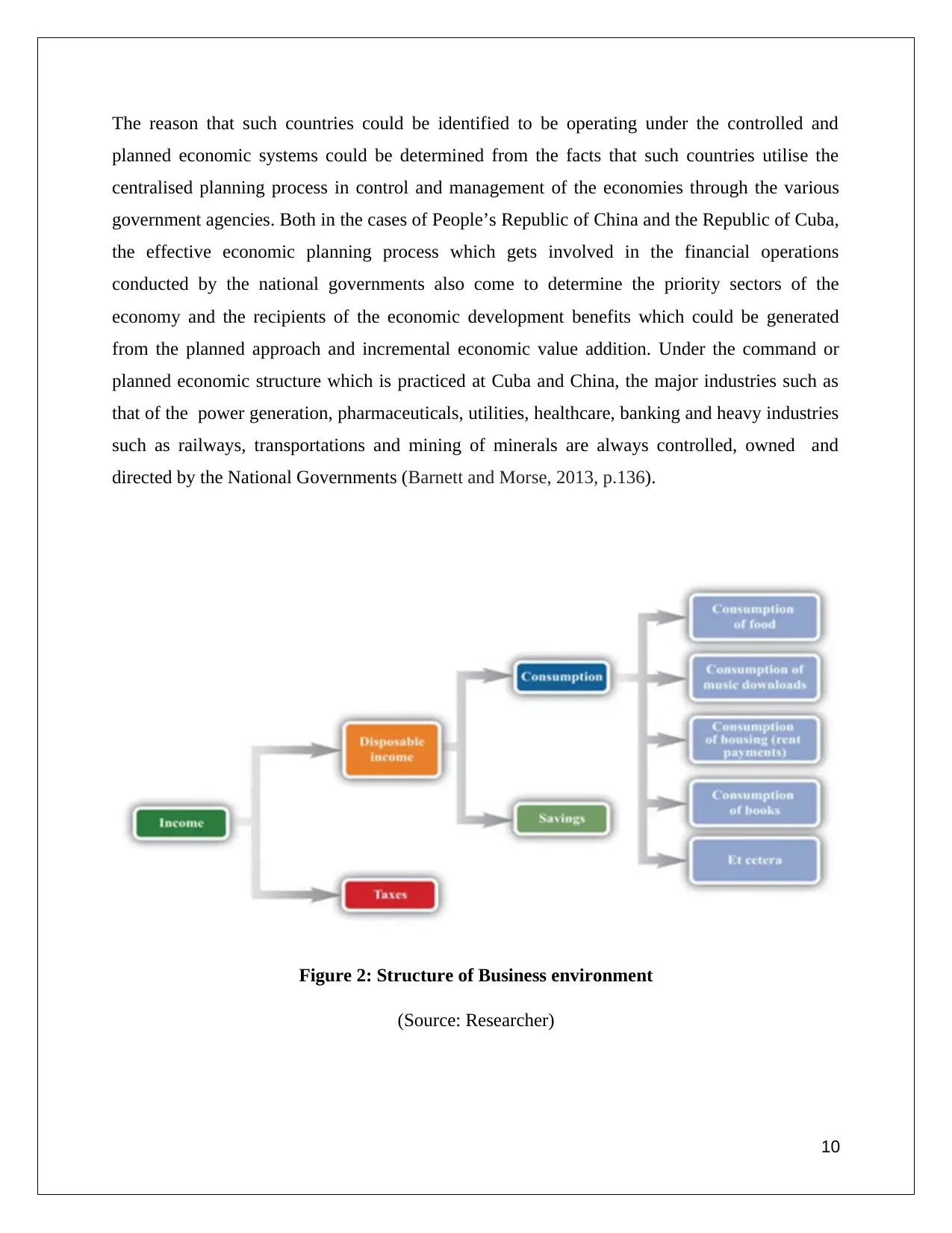
The reason that such countries could be identified to be operating under the controlled and
planned economic systems could be determined from the facts that such countries utilise the
centralised planning process in control and management of the economies through the various
government agencies. Both in the cases of People’s Republic of China and the Republic of Cuba,
the effective economic planning process which gets involved in the financial operations
conducted by the national governments also come to determine the priority sectors of the
economy and the recipients of the economic development benefits which could be generated
from the planned approach and incremental economic value addition. Under the command or
planned economic structure which is practiced at Cuba and China, the major industries such as
that of the power generation, pharmaceuticals, utilities, healthcare, banking and heavy industries
such as railways, transportations and mining of minerals are always controlled, owned and
directed by the National Governments (Barnett and Morse, 2013, p.136).
Figure 2: Structure of Business environment
(Source: Researcher)
10
planned economic systems could be determined from the facts that such countries utilise the
centralised planning process in control and management of the economies through the various
government agencies. Both in the cases of People’s Republic of China and the Republic of Cuba,
the effective economic planning process which gets involved in the financial operations
conducted by the national governments also come to determine the priority sectors of the
economy and the recipients of the economic development benefits which could be generated
from the planned approach and incremental economic value addition. Under the command or
planned economic structure which is practiced at Cuba and China, the major industries such as
that of the power generation, pharmaceuticals, utilities, healthcare, banking and heavy industries
such as railways, transportations and mining of minerals are always controlled, owned and
directed by the National Governments (Barnett and Morse, 2013, p.136).
Figure 2: Structure of Business environment
(Source: Researcher)
10
Paraphrase This Document
Need a fresh take? Get an instant paraphrase of this document with our AI Paraphraser
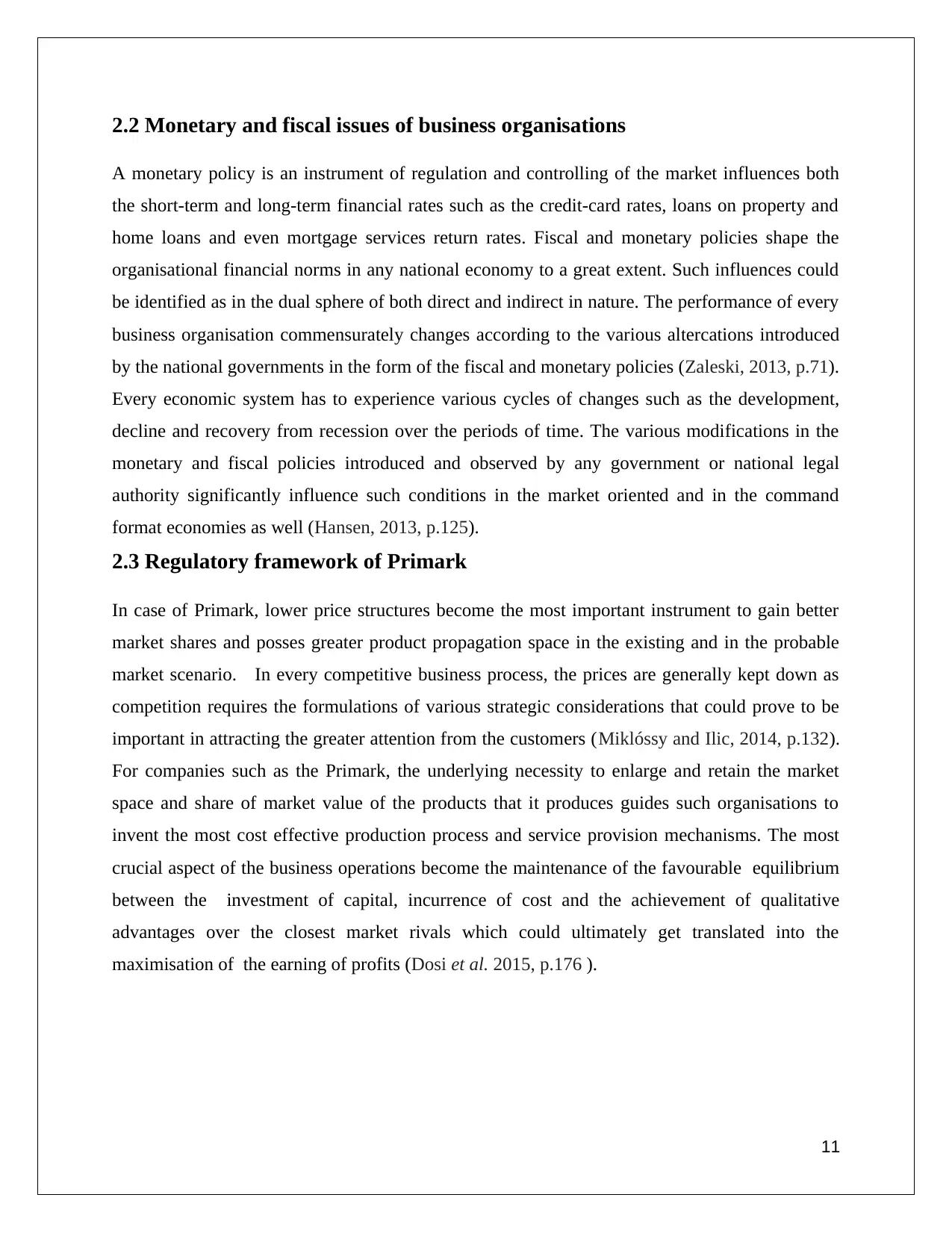
2.2 Monetary and fiscal issues of business organisations
A monetary policy is an instrument of regulation and controlling of the market influences both
the short-term and long-term financial rates such as the credit-card rates, loans on property and
home loans and even mortgage services return rates. Fiscal and monetary policies shape the
organisational financial norms in any national economy to a great extent. Such influences could
be identified as in the dual sphere of both direct and indirect in nature. The performance of every
business organisation commensurately changes according to the various altercations introduced
by the national governments in the form of the fiscal and monetary policies (Zaleski, 2013, p.71).
Every economic system has to experience various cycles of changes such as the development,
decline and recovery from recession over the periods of time. The various modifications in the
monetary and fiscal policies introduced and observed by any government or national legal
authority significantly influence such conditions in the market oriented and in the command
format economies as well (Hansen, 2013, p.125).
2.3 Regulatory framework of Primark
In case of Primark, lower price structures become the most important instrument to gain better
market shares and posses greater product propagation space in the existing and in the probable
market scenario. In every competitive business process, the prices are generally kept down as
competition requires the formulations of various strategic considerations that could prove to be
important in attracting the greater attention from the customers (Miklóssy and Ilic, 2014, p.132).
For companies such as the Primark, the underlying necessity to enlarge and retain the market
space and share of market value of the products that it produces guides such organisations to
invent the most cost effective production process and service provision mechanisms. The most
crucial aspect of the business operations become the maintenance of the favourable equilibrium
between the investment of capital, incurrence of cost and the achievement of qualitative
advantages over the closest market rivals which could ultimately get translated into the
maximisation of the earning of profits (Dosi et al. 2015, p.176 ).
11
A monetary policy is an instrument of regulation and controlling of the market influences both
the short-term and long-term financial rates such as the credit-card rates, loans on property and
home loans and even mortgage services return rates. Fiscal and monetary policies shape the
organisational financial norms in any national economy to a great extent. Such influences could
be identified as in the dual sphere of both direct and indirect in nature. The performance of every
business organisation commensurately changes according to the various altercations introduced
by the national governments in the form of the fiscal and monetary policies (Zaleski, 2013, p.71).
Every economic system has to experience various cycles of changes such as the development,
decline and recovery from recession over the periods of time. The various modifications in the
monetary and fiscal policies introduced and observed by any government or national legal
authority significantly influence such conditions in the market oriented and in the command
format economies as well (Hansen, 2013, p.125).
2.3 Regulatory framework of Primark
In case of Primark, lower price structures become the most important instrument to gain better
market shares and posses greater product propagation space in the existing and in the probable
market scenario. In every competitive business process, the prices are generally kept down as
competition requires the formulations of various strategic considerations that could prove to be
important in attracting the greater attention from the customers (Miklóssy and Ilic, 2014, p.132).
For companies such as the Primark, the underlying necessity to enlarge and retain the market
space and share of market value of the products that it produces guides such organisations to
invent the most cost effective production process and service provision mechanisms. The most
crucial aspect of the business operations become the maintenance of the favourable equilibrium
between the investment of capital, incurrence of cost and the achievement of qualitative
advantages over the closest market rivals which could ultimately get translated into the
maximisation of the earning of profits (Dosi et al. 2015, p.176 ).
11
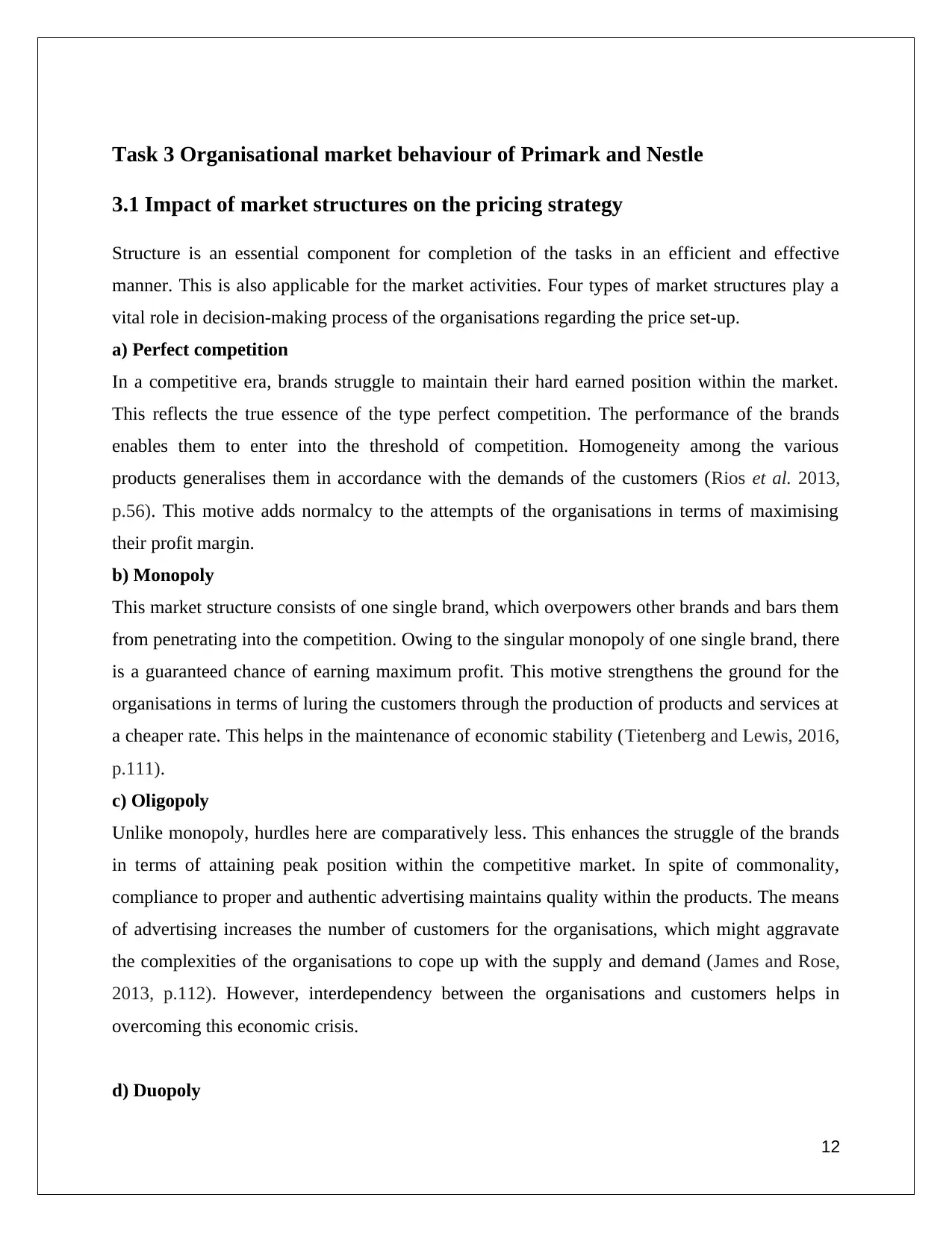
Task 3 Organisational market behaviour of Primark and Nestle
3.1 Impact of market structures on the pricing strategy
Structure is an essential component for completion of the tasks in an efficient and effective
manner. This is also applicable for the market activities. Four types of market structures play a
vital role in decision-making process of the organisations regarding the price set-up.
a) Perfect competition
In a competitive era, brands struggle to maintain their hard earned position within the market.
This reflects the true essence of the type perfect competition. The performance of the brands
enables them to enter into the threshold of competition. Homogeneity among the various
products generalises them in accordance with the demands of the customers (Rios et al. 2013,
p.56). This motive adds normalcy to the attempts of the organisations in terms of maximising
their profit margin.
b) Monopoly
This market structure consists of one single brand, which overpowers other brands and bars them
from penetrating into the competition. Owing to the singular monopoly of one single brand, there
is a guaranteed chance of earning maximum profit. This motive strengthens the ground for the
organisations in terms of luring the customers through the production of products and services at
a cheaper rate. This helps in the maintenance of economic stability (Tietenberg and Lewis, 2016,
p.111).
c) Oligopoly
Unlike monopoly, hurdles here are comparatively less. This enhances the struggle of the brands
in terms of attaining peak position within the competitive market. In spite of commonality,
compliance to proper and authentic advertising maintains quality within the products. The means
of advertising increases the number of customers for the organisations, which might aggravate
the complexities of the organisations to cope up with the supply and demand (James and Rose,
2013, p.112). However, interdependency between the organisations and customers helps in
overcoming this economic crisis.
d) Duopoly
12
3.1 Impact of market structures on the pricing strategy
Structure is an essential component for completion of the tasks in an efficient and effective
manner. This is also applicable for the market activities. Four types of market structures play a
vital role in decision-making process of the organisations regarding the price set-up.
a) Perfect competition
In a competitive era, brands struggle to maintain their hard earned position within the market.
This reflects the true essence of the type perfect competition. The performance of the brands
enables them to enter into the threshold of competition. Homogeneity among the various
products generalises them in accordance with the demands of the customers (Rios et al. 2013,
p.56). This motive adds normalcy to the attempts of the organisations in terms of maximising
their profit margin.
b) Monopoly
This market structure consists of one single brand, which overpowers other brands and bars them
from penetrating into the competition. Owing to the singular monopoly of one single brand, there
is a guaranteed chance of earning maximum profit. This motive strengthens the ground for the
organisations in terms of luring the customers through the production of products and services at
a cheaper rate. This helps in the maintenance of economic stability (Tietenberg and Lewis, 2016,
p.111).
c) Oligopoly
Unlike monopoly, hurdles here are comparatively less. This enhances the struggle of the brands
in terms of attaining peak position within the competitive market. In spite of commonality,
compliance to proper and authentic advertising maintains quality within the products. The means
of advertising increases the number of customers for the organisations, which might aggravate
the complexities of the organisations to cope up with the supply and demand (James and Rose,
2013, p.112). However, interdependency between the organisations and customers helps in
overcoming this economic crisis.
d) Duopoly
12
⊘ This is a preview!⊘
Do you want full access?
Subscribe today to unlock all pages.

Trusted by 1+ million students worldwide
1 out of 20
Related Documents
Your All-in-One AI-Powered Toolkit for Academic Success.
+13062052269
info@desklib.com
Available 24*7 on WhatsApp / Email
![[object Object]](/_next/static/media/star-bottom.7253800d.svg)
Unlock your academic potential
Copyright © 2020–2025 A2Z Services. All Rights Reserved. Developed and managed by ZUCOL.





